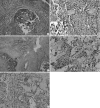Ghost cell odontogenic carcinoma arising from calcifying cystic odontogenic tumor: a case report
- PMID: 23136575
- PMCID: PMC3490111
- DOI: 10.4132/KoreanJPathol.2012.46.5.478
Ghost cell odontogenic carcinoma arising from calcifying cystic odontogenic tumor: a case report
Abstract
Ghost cell odontogenic carcinoma (GCOC) is an exceptionally rare and malignant odontogenic tumor with aggressive growth characteristics. We describe a case of GCOC which was considerably derived from a previously resected calcifying cystic odontogenic tumor (CCOT). Cellular atypia, mitotic activity, Ki-67 labeling index and matrix metalloprotease-9 positive expression rate were all increased in the currently resected specimen compared to the initial one. This is a rare case of malignant transformation of CCOT to GCOC with respect to its histopathological and immunohistochemical findings.
Keywords: Calcifying cystic odontogenic tumor; Ghost cell odontogenic carcinoma.
Conflict of interest statement
No potential conflict of interest relevant to this article was reported.
Figures



Similar articles
-
Predictive factors of potential malignant transformation in recurrent calcifying cystic odontogenic tumor: review of the literature.Case Rep Pathol. 2013;2013:853095. doi: 10.1155/2013/853095. Epub 2013 Jul 15. Case Rep Pathol. 2013. PMID: 23956907 Free PMC article.
-
Malignant transformation of calcifying cystic odontogenic tumour - a review of literature.Contemp Oncol (Pozn). 2015;19(3):184-6. doi: 10.5114/wo.2015.52654. Epub 2015 Jul 8. Contemp Oncol (Pozn). 2015. PMID: 26557757 Free PMC article. Review.
-
The expression of NF-kappaB, Ki-67 and MMP-9 in CCOT, DGCT and GCOC.Oral Oncol. 2009 Jun;45(6):515-20. doi: 10.1016/j.oraloncology.2008.07.004. Epub 2008 Aug 23. Oral Oncol. 2009. PMID: 18723387
-
Ghost cell odontogenic carcinoma arising in calcifying odontogenic cyst.Ann Diagn Pathol. 2009 Dec;13(6):394-7. doi: 10.1016/j.anndiagpath.2009.02.008. Epub 2009 Apr 19. Ann Diagn Pathol. 2009. PMID: 19917476
-
Ghost Cell Odontogenic Carcinoma Arising in a Previous Calcifying Odontogenic Cyst: A Case Report and Review of Literature.Head Neck Pathol. 2022 Sep;16(3):828-835. doi: 10.1007/s12105-022-01445-6. Epub 2022 Apr 7. Head Neck Pathol. 2022. PMID: 35389163 Free PMC article. Review.
Cited by
-
Ghost cell odontogenic carcinoma of the maxilla: a case report with a literature review.Pan Afr Med J. 2015 Aug 7;21:260. doi: 10.11604/pamj.2015.21.260.5139. eCollection 2015. Pan Afr Med J. 2015. PMID: 26523195 Free PMC article. Review.
-
Ghost Cell Odontogenic Carcinoma Arising Denovo with Distant Metastasis: A Case Report and Review of Literature.J Clin Diagn Res. 2017 Aug;11(8):ZD01-ZD03. doi: 10.7860/JCDR/2017/28143.10445. Epub 2017 Aug 1. J Clin Diagn Res. 2017. PMID: 28969291 Free PMC article.
-
Predictive factors of potential malignant transformation in recurrent calcifying cystic odontogenic tumor: review of the literature.Case Rep Pathol. 2013;2013:853095. doi: 10.1155/2013/853095. Epub 2013 Jul 15. Case Rep Pathol. 2013. PMID: 23956907 Free PMC article.
-
Ghost cell odontogenic carcinoma with suspected cholesterol granuloma of the maxillary sinus in a patient treated with combined modality therapy: A case report and the review of literature.Medicine (Baltimore). 2018 Feb;97(7):e9816. doi: 10.1097/MD.0000000000009816. Medicine (Baltimore). 2018. PMID: 29443742 Free PMC article. Review.
-
Ki-67 and p53 expression in ghost cell odontogenic carcinoma: a case report and literature review.Oral Maxillofac Surg. 2015 Mar;19(1):85-9. doi: 10.1007/s10006-014-0465-2. Epub 2014 Sep 14. Oral Maxillofac Surg. 2015. PMID: 25216652 Review.
References
-
- Goldenberg D, Sciubba J, Koch W, Tufano RP. Malignant odontogenic tumors: a 22-year experience. Laryngoscope. 2004;114:1770–1774. - PubMed
-
- Ledesma-Montes C, Gorlin RJ, Shear M, et al. International collaborative study on ghost cell odontogenic tumours: calcifying cystic odontogenic tumour, dentinogenic ghost cell tumour and ghost cell odontogenic carcinoma. J Oral Pathol Med. 2008;37:302–308. - PubMed
-
- Goldenberg D, Sciubba J, Tufano RP. Odontogenic ghost cell carcinoma. Head Neck. 2004;26:378–381. - PubMed
-
- Tanaka N, Iwaki H, Yamada T, Amagasa T. Carcinoma after enucleation of a calcifying odontogenic cyst: a case report. J Oral Maxillofac Surg. 1993;51:75–78. - PubMed
-
- Ellis GL, Shmookler BM. Aggressive (malignant?) epithelial odontogenic ghost cell tumor. Oral Surg Oral Med Oral Pathol. 1986;61:471–478. - PubMed
LinkOut - more resources
Full Text Sources

